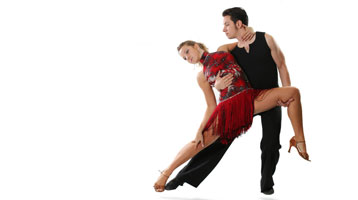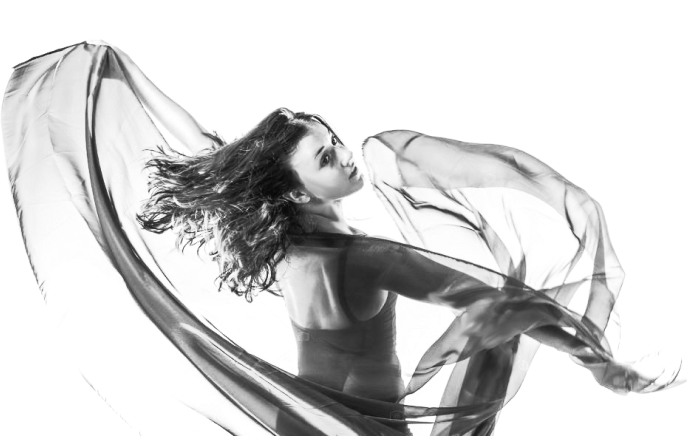
Latin Dance
Paso Doble
The Paso Doble is a theatrical Latin dance with Spanish and French origins. It is a dramatic dance that tells a story through sharp, staccato movements, striking body poses, and flamenco style footwork.
History of the Paso Doble
Although there is not a lot of recorded history written about the Paso Doble dance, there are some shared beliefs about the dance’s origins and evolution. The Paso Doble is a passionate dance based on a Spanish bullfight. The leader represents the proud Spanish matador and the woman or follower is the Matador’s cape. The follower will sometimes also represent the bull, picador or flamenco dancer. Paso Doble music was originally played for the entrance of the matador into the bull-fighting ring. In Spainish tradition dating back to the 18th century, it was also known as “El Soleo”. Although the Paso Doble is based on a Spanish tradition, it’s believed that the dance was created in Southern France where they tried to portray the theatrics of the Spanish bullfight.
The name of the dance, “Paso Doble” is believed to trace back to a French military march with a similar name, “Paso Redoble.” The Paso Redoble was a march with a 2/4 beat and about 130 beats or steps per minute. Even today the Paso Doble dance is characterized by it’s marching-like steps and is now the fastest Latin ballroom dance. Every second step of the marching dance is emphasized, and this may also be why the dance is called “Paso Doble” or translated to English “double step”
While the Paso Doble dance has Spanish and French roots, a lot of the dance was developed and interpreted in Southern France around 1910 by French competition dance performers and instructors. The French’s development of the Paso Doble dance is why the dance’s figures and steps were coined with French names. In the 1920s choreographed bull fight pantomimes emerged out of the Paso Doble dance. Performing dance was a big novelty during this time and lent to the Paso Doble’s success.
Paso Doble received the coin term “dance of the master” because of the boldness and beaming pride expressed by the “torero” in the dance. The strength and decisiveness of the lead was interpreted as that of a master. The female follow, much like in Flamenco dance, also dances with a kind of self-confidence, beaming elegance and strength at the same time. The Paso Doble adopted some elements of the figures, steps, and character of Flamenco dancing.
Paso Doble Today
Paso Doble dancing gained popularity in the United States in the 1930s. Although today the Paso Doble is on occasion danced as a social ballroom or Latin dance, it is generally seen as a competitive or performance style dance. Due to its French origins, most of the steps in the Paso Doble have still French names. The Paso Doble has strong progressive steps, often using stomps and flamenco type footwork for dramatic effects. The body actions are sharp and quick and the chest is held high and proud. The sharp moves of Paso Doble dance make it a popular dance to be choreographed. Dancers are better able to hit strong movements with a planned dance making for a very dramatic effect.
The Paso Doble has gained popularity through competitive dance reality TV shows like, “Dancing With the Stars.” On “Dancing with the Stars”, they often use contemporary pop music to create a more current sound for the Paso Doble. These dances are choreographed with the dance judges in mind, striving to excel in performing all the essential characteristics of the Paso Doble dance.
In addition to being danced to modern pop songs, a significant amount of Paso Doble dances are still performed to the traditional music “Epaña Cañi”, a famous Spanish song written by Pascual Marquina Narro in 1921. “España Cañi” continues to be popular today with Paso Doble dancers today. It’s often known as “the Paso Doble Song” and is commonly played in dance competitions because its significant breaks and musical structure lend well for specific and successful Paso Doble choreography.
Today the Paso Doble is considered a dance that teaches discipline as it gives dancing a strong structure and little artistic freedom. A lot of practice is needed to perform the Paso Doble successfully because of the expressiveness and strict musicality of the dance. When dancing in closed position, Paso Doble dancers have continuous body contact from chest to thigh and hold their hands much higher than the other competition dances. Paso Doble has been a competition dance since 1945 and has been a part of the World Dance Program since 1963. Within competitive dance, modern Paso Doble is combined with Samba, Cha-Cha, Rumba and Jive under the category International Latin.
Paso Doble Dance Music
- “Espana Cani” various artists
- “Spanish Gypsy Dance” Orquestra Carrasco
- “Bring Me to Life” Evanescence
- “Amparito Roca” Luis Cobos
- “Bad Romance” Lady Gaga
- “Malaguena” Edmundo Ros
- “El Pico” Orquesta Torres Avila
- “Uprising” Muse
- “Volare” Gypsy Kings
- “Bambolero” Gypsy Kings
- “Thriller” Michael Jackson
- “Eye of the Tiger” Survivor
- “Dirty Little Secret” The All-American Rejects
- “Matador Paso” Andy Fortuna
- “Pinball Wizard” Tanz Orchester Klaus Hallen
- “I Write Sins Not Tragedies” Panic! At The Disco
- “S.O.S.” Rihanna
- “Call Me When You’re Sober” Evanescence
- “Temperature” Sean Paul
- “Paralyzer” Finger Eleven
- “Don’t Stop the Music” Rihanna
- “Dance, Dance” Fall Out Boy
- “Sexy Back” Justin Timberlake
- “Time is Running Out” Muse
- “Conquest” The White Stripes
- “Purple Haze” Jimi Hendrix
- “Don’t Let Me Be Misunderstood” Tanz Orchester Klaus Hallen
- “El Magnifico” Tim Devine, Ned Milton, and Andrea Terrano
- “Spanish Bull” Miguel Moreno
- “Spanish Overture” Tim Garland
- “Bad Romance” Lady Gaga
- “Another One Bites the Dust” Queen
- “Applause” Lady Gaga
- “Free Your Mind” EnVogue
- “Turn Me On” Nicki Minaj
- “What Doesn’t Kill You (Stronger)” Kelly Clarkson
- “We Are Never Ever Getting Back Together” Taylor Swift
- “Bring Me to Life” Evanescence
- “Livin’ On a Prayer” Bon Jovi
- “Scream” Usher
- “We Will Rock You” Queen
- “Higher Ground” Stevie Wonder
- “Cancion del Mariachi” Los Lobos and Antonio Banderas
- “Don’t Let Me Be Misunderstood” Kill Bill Soundtrack
- “Paparazzi” Lady Gaga
- “Rhythm is a Dancer” Snap!
- “Spanish Guitar” Bo Diddley
- “U Got The Look” Prince


